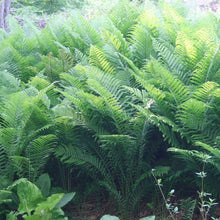Ostrich Fern (Matteuccia struthiopteris) is a bold architectural fern with tall upright fronds that unfurl like ostrich plumes in spring. Forms elegant colonies in shady gardens and is especially effective for creating texture and height in naturalistic plantings.
Height & Spread: 36 - 60 in x 24 - 36 in
Bloom Time: Non flowering
Light Requirements: Part shade to full shade
Soil Preference: Moist, fertile, humus rich soil; tolerates seasonal flooding
Watering Needs: Moderate to high; prefers consistent moisture
Deer Resistance: Generally deer resistant
Native Status
This species is native to temperate regions of North America, particularly the northeast and upper Midwest, where it thrives in wet woods and along streams.
WILDLIFE & INSECTS
Birds
- Provides protective cover for ground nesting birds such as thrushes and sparrows, and the dense growth helps shelter fledglings and insects they feed on.
Beneficial Insects
- The dense, shady base of ostrich fern colonies offers habitat for ground beetles, spiders, and other beneficial invertebrates.
Spacing & Landscape Use
Spacing Recommendations
- Space 24 - 36 in apart to allow the tall fronds to spread and create lush colonies over time.
Landscape Placement
- Ideal for large shade gardens, rain gardens, streambanks, or woodland edges where bold foliage and moisture retention are desired.
Companion Plants
- Adiantum pedatum (Northern Maidenhair Fern) - Provides contrasting fine foliage texture in shaded woodland plantings.
- Hydrophyllum virginianum (Virginia Waterleaf) - Adds quick spring cover and flowers before ferns reach full height.
- Arisaema triphyllum (Jack in the Pulpit) - Adds sculptural interest among the upright ostrich fern fronds.
- Caltha palustris (Marsh Marigold) - Offers golden yellow spring blooms in similar moist habitats.
- Carex grayi (Grays Sedge) - Offers striking spiky seed heads and thrives in the same rich soils.



